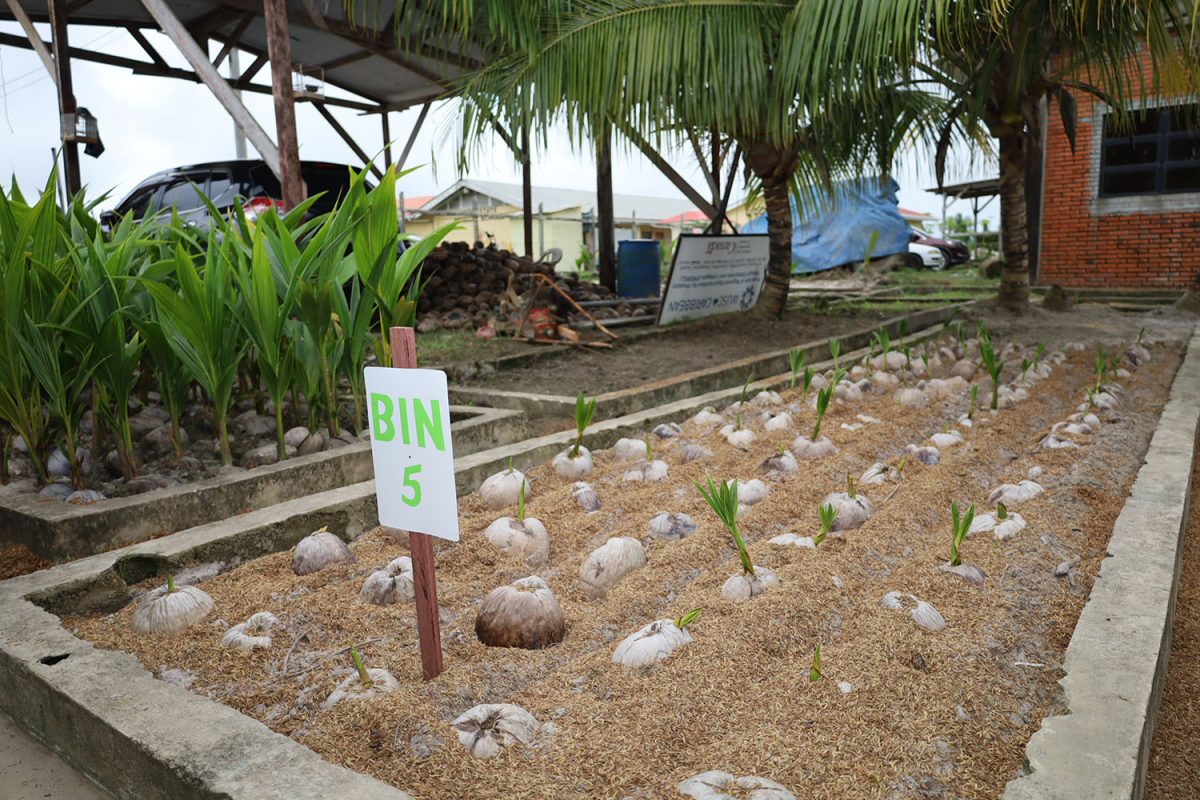The Brazilian Green Dwarf coconut variety has officially been introduced in Guyana through an arrangement between the Ministry of Agriculture (MoA) and the Caribbean Agriculture Research and Development Institute (CARDI).
Its introduction was conceptualized following discussions held during the inaugural Agri-Investment Forum and Expo in Guyana last May.
According to a statement by the MoA, the first shipment of 1,000 seed nuts arrived in Guyana from Brazil in October. This will result in detailed research and product development for the coconut industry in Guyana.
“The Brazilian Green Dwarf variety is best known for its high-yielding properties, as well as its high tolerance to attacks from common pests and diseases that usually affect other varieties of coconuts. Its most outstanding characteristic, however, is its ability to produce a higher volume of water than other varieties commonly grown in Guyana. This variety is also said to produce water that has a very high sucrose level, making it sweeter than other varieties,” the ministry statement said.
At the launching, Agriculture Minister Zulfikar Mustapha said coconut is one of the priority commodities that has been identified for increased production.
“Approximately $1.5 billion was earned from the export of coconut and coconut products during the period January to September 2022. As CARICOM seeks to reduce the food import bill by 25% by 2025, with Guyana having the lead responsibility of agriculture in the region, coconut is one of the priority commodities that has been identified for increased production. A large portion of the coconut industry engages in the primary processing of coconut. We are working with our private sector counterpart to produce more value-added products,” Mustapha was quoted as saying.
With the international coconut industry being anticipated to grow tremendously by 2026, he said, it is critical for Guyana to ensure it was in a place to tap into that market.
“Internationally, the coconut industry is expected to be a USD 30 Billion industry by 2026, therefore it is important for us to set the stage to tap into this market. We will be working to develop industries utilizing four popular by-products of coconut which include the husk, shell, meat, and water. This is why the ministry has been working to develop coconut nurseries and decentralize the production of coconut seedlings across the country. Through close collaboration with CARDI, Hope Estate was able to develop one of its first coconut nurseries under the National Coconut Decentralization Programme. This intervention has seen further expansions over the past two years. This has led to Guyana becoming one of the leading producers of coconut seedlings in CARICOM,” he added.
It is expected that an additional 1,000 seed nuts will arrive in Guyana before the end of the year.
During the launching, General Manager of Hope Industries Limited, Ricky Roopchand said that the Hope Estate was able to improve its seedling production capacity tremendously over the last two years.
“Over the last two years with the government’s support, we’ve expanded the local coconut industry in terms of seedling production. We now have nine seedling nurseries across the country, with the tenth expected to be established soon in Lethem. If these nurseries are operated at full capacity. With the support of CARDI and the EU (European Union), by the end of the year, we would’ve acquired some 2,000 Brazilian Green Dwarf seed nuts that will be used for developing plantations across the ten administrative regions of Guyana,” he said.
The European Union Ambassador to Guyana, Rene van Nes in his remarks said that the coconut sector will also play a role in Guyana’s Green Goal and presents a win-win situation for everyone involved, according to the MoA.
“I’m really proud that the European Union is supporting Guyana and the Guyanese farmers to create better livelihoods for all the people involved in the production, processing, and distribution of coconuts and its by-products. The coconut sector in Guyana is contributing to the Green Goal, for example by inter-cropping, you really make sure that you have more biodiversity, you’ll need less pest control, and you’ll diversify the income from the land. This presents a win-win situation for all those involved,” van Nes said.
According to the MoA, the introduction of the Brazilian Green Dwarf variety will result in the expansion of Guyana’s local genetic diversity adding to the government’s efforts to further develop its national coconut breeding programme which is expected to commence shortly.






